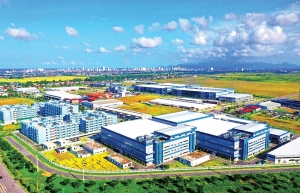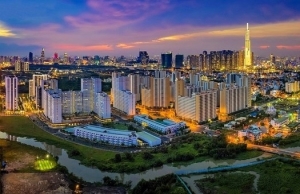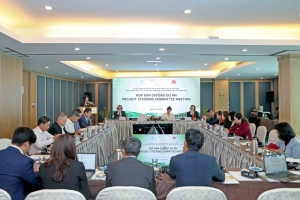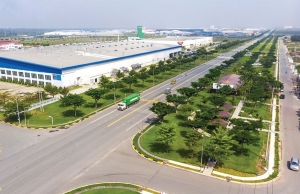Nation must scoop up benefits of high-tech industrial parks
Is development of high-tech industrial parks (IPs) likely to become a new capital trend in Vietnam?
 |
| David Jackson, CEO of Colliers Vietnam |
Industrial and logistics assets are two of the most in-demand real estate areas across Asia-Pacific in 2023. As investors adopt a defensive strategy, sustainability and technology will drive changes in reassessing portfolios, focusing on quality and long-term values such as green certifications, new amenities, costs, and operational efficiency.
Different industrial models in Vietnam will thus also be impacted by these factors in the next few years. Yet, it is too early to say whether the investment in and development of high-tech parks will become a new trend. High-tech IPs in Vietnam have not yet reached their full potential due to a lack of attention. There is much to do in terms of removing legal barriers, completing the technology infrastructure, and offering more favourable conditions to encourage investors to join the segment.
How do you now evaluate investment in these types of IPs in Vietnam and how challenging is it to expand this sector?
A lot of the potential is untapped. Currently, the country has only four high-tech parks: in Danang, Ho Chi Minh City (SHTP), Hoa Lac in Hanoi, and Dong Nai province’s biotechnology park. In comparison, there are almost 400 IPs in operation and over 160 under construction nationwide.
Despite the modest scale, high-tech parks are a typical model of IT industrial development that the Vietnamese government aims for. Some of these parks have attracted large and well-known corporations. For example, Intel, Nidec, Samsung, and Nipro have chosen SHTP as their high-tech destination in Vietnam. High-quality human resources also tend to work in those parks to facilitate their research activities.
However, the expansion of high-tech parks in Vietnam faces challenges. In terms of supply, besides limited numbers, the scale and conditions are not suitable enough, hindering the process. Take Danang Hi-Tech Park as an example: though there is a large land bank available at the park, the province’s climatic environment is less favourable for high-tech manufacturing as compared to other regions. Or at SHTP, the slow acquisition of land from delayed projects may defer investing plans.
Another factor is that the technical and service infrastructure has not yet met the requirements to create a sci-tech ecosystem – one of the conditions to establish a high-tech park. These include an on-site data centre, startup hub, laboratory, 5G network, and state-of-the-art facilities.
Some issues in the mechanisms and policies of high-tech park development and expansion still confuse provinces in real-life execution. Moreover, the management structure of such parks is different from that of normal IPs, yet it has not kept pace with specialised regulations and laws.
High-tech IPs are capital-intensive. How does this affect the development of this segment?
Price is crucial, especially in the context of rising interest rates, inflation, and construction costs. However, based on my experience working with industrial developers, I believe that the development of a high-tech park returns more benefits and profits to all stakeholders in the long term.
Brand new projects in such parks receive much more attractive corporate income tax (CIT) incentives than conventional complexes. Depending on the scale and project value, investors will enjoy the incentives for 15-30 years.
Not only do investors benefit from free land rent during the construction period, but they are also entitled to an exemption in CIT in the first four years, a 50 per cent reduction over the next nine years, and more besides, when compared to normal IPs.
One factor that makes high-tech parks more appealing to investors is their strategic location. These zones are usually planned in the locality’s key areas, including easy access to the city centre and the transportation system, and being near large IPs.
 | Localities keen to implement advanced industrial parks Localities nationwide are eager to accelerate the construction of industrial parks to welcome new foreign investment capital inflows in 2023. |
 | Vietnamese real estate remain attractive to foreign investors The Vietnamese real estate market has remained attractive to foreign investors and investment funds despite difficulties countering domestic firms, according to insiders. |
 | Vietnam to promote eco-industrial parks with international partners The Steering Committee on the Development of Eco-industrial Parks in Vietnam, organised a meeting yesterday to discuss last year's results and set a course for the following two years of the scheme. |
 | SEP Group plans carbon-neutral industrial park in Binh Duong SEP Group from Korea is interested in developing a $200 million carbon-neutral industrial complex in the southern province of Binh Duong. |
 | Localities crack on with IP construction Heavy investment into industrial park infrastructure is being made in the hopes of it becoming a significant source of revenue. |
What the stars mean:
★ Poor ★ ★ Promising ★★★ Good ★★★★ Very good ★★★★★ Exceptional
Related Contents
Latest News
More News
- Main drivers for Vietnam’s digital economy future (December 03, 2025 | 11:35)
- Pivotal stage of growth paves way for rise in M&As (December 03, 2025 | 10:00)
- Positive projections for M&A interest from Thailand (December 03, 2025 | 09:40)
- Manifesting the first line of defence in cybersecurity (December 03, 2025 | 09:00)
- The transformational role AI can play in accounting arena (December 03, 2025 | 08:00)
- Unlocking 5G-AI potential in Singapore (December 03, 2025 | 08:00)
- Data-driven strategies vital for a fast-evolving nation (December 02, 2025 | 09:41)
- Policy to practice: how Vietnam can lead the region (November 26, 2025 | 16:03)
- Mobilising private capital at scale vital for climate battle (November 26, 2025 | 15:36)
- VILAF and Yoon & Yang launch Vietnam - Korea Practice Unit (November 26, 2025 | 15:16)

 Tag:
Tag:





















 Mobile Version
Mobile Version